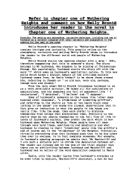Language and Identity in Emily Brontë`s Wuthering Heights
A study of environmental metaphors and characterization.
Engl. 330/3
Jeremy P. Chapman
Emily Brontë' s Wuthering Heights is a novel that depends heavily on descriptive writing in order to illustrate details of her character's inner thoughts and being. Language functions as a social and sexual mediator in this book, and performs many additional functions. Language is the tool that undoes Catherine Linton, language is what Hareton is lacking, and through Nelly, language is how we hear the tale of Wuthering Heights itself. Identity through writing is the goal of most writings, and in Wuthering Heights Brontë succeeds admirably. The majority of the metaphors that are employed in Wuthering Heights are environmental, pertaining to the surrounding countryside or its non-human inhabitants. This essay will discuss the language Brontë has used in order to give further meaning to her main characters, and will focus especially on metaphors taken from the natural world of Wuthering Heights.
Heathcliff is probably the most deeply despised character in the book, by both readers and characters alike. From the very start of the novel, when Lockwood (the narrator at the moment) first encounters Heathcliff we find strong opinions about his character, both shown and hidden. Lockwood thinks he is reading Heathcliff properly when he says "His reserve springs from an aversion to showy displays of feeling - to manifestations of mutual kindliness" (p. 5). We as readers however, know that this is not necessarily true. Lockwood is an unreliable narrator who will tell the reader what he feels about someone in the same way that he would describe their appearance. Simply because he phrases it in a similar way to that of an omniscient narrator, Lockwood taints Heathcliff's first meeting with his audience. It is a mediating presence that Lockwood brings, for Brontë needs to make us partly sympathetic to this character in order to understand the profound change he goes through. By the time Catherine Earnshaw/Linton is dying, and Heathcliff is spending every possible moment outside her house, Nelly says ""His visits were a continual nightmare to me; and, I suspected, to my master also. His abode at the Heights was an oppression past explaining. I felt that God had forsaken the stray sheep there to its own wicked wanderings, and an evil beast prowled between it and the fold, waiting his time to spring and destroy."(p. 106). A wicked image to be sure, and not far off from the truth. Nelly is perceptive in sensing danger that may befall either her or her masters, and even though she is safe from the menace, she knows that someone will be hurt. We see then how Heathcliff undergoes an immense change in the eyes of the reader by the middle of the book. He has betrayed the feeble trust we had in him as a child, and is now a seemingly evil creature. Brontë skips Heathcliff's adolescence, and so the reader remembers him as a child, innocent and incapable of such trickery as he is now a part of. This rather sudden personality change serves to heighten our distaste for the miscreant, and allows Brontë to kill Catherine Earnshaw/Linton without an attendant loss in interest from the reader, for we must know how Heathcliff will react, be punished and so on. The debate in literary circles around Heathcliff seems to center on whether he is truly evil, a demon of some sort or possessed by Satan. He is however, modified by his relation to Catherine who both tempers and enrages him. However, his evil can be seen as a jealous tribute to Catherine rather than simply a spiteful nature. Catherine thinks that this is so, evidenced by her description of Heathcliff as compared to Edgar Linton "Whatever our souls are made of, his and mine are the same, and Linton's is as different as a moonbeam from lightning, or frost from fire."(p. 80). Catherine believes that her and Heathcliff's souls are made up of the same constituents, yet her future life belies this. She is destined for a life of womanly marriage and a sorrowful death, he to the life of a rough traveller at first and bitter tyranny at last. She is a gentler soul than he, and her affection for him stems from the time that she was able to roam free over the moors with him, when their relation was without, for the most part, sexual or social pressures. The fact that Catherine refers to Linton as being as a "moonbeam" and "frost" shows a fair amount about her regard for him. He is more distant and cool than Heathcliff, who is "lightning" and "fire". The cold/hot duality of these characters is interesting, giving further proof of the elemental nature of their identity. Linton as the sedate and genteel husband, Heathcliff as the stormy and fiery lover. Catherine at times does tire of Heathcliff, and desires more intellectual stimulation. Once, annoyed at Heathcliff, she describes the contrast between Linton and Heathcliff: "The contrast resembled what you see in exchanging a bleak, hilly, coal country for a beautiful fertile valley..."(p.69). Here, the environmental metaphor works again, contrasting craggy lifeless country with a pastoral valley full of life. Heathcliff is, for Catherine, devoid of the intellectualism she seeks.







